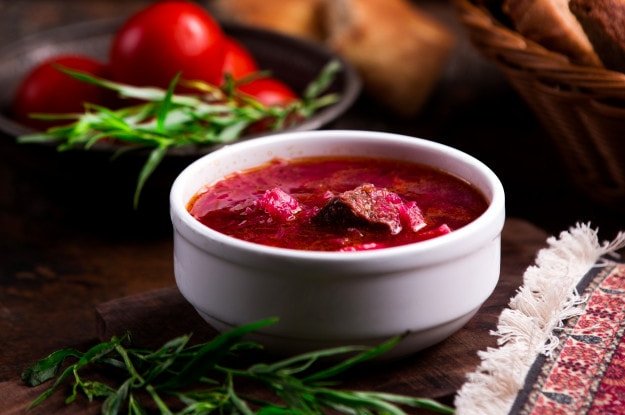The Ukrainian diaspora in Canada found this recipe of Red Ukrainian Borsch with Flour in an old cookbook published in 1917 in Edmonton, Alberta. This book contains several authentic Ukrainian recipes that everyone has forgotten about.
The book was called “Ukrainian-English cook”. We will adapt the recipe of Ukrainian borsch to modern cooking. But just a little. Because ideally, you need to use a pot of pottery and put it in the oven. So, how to cook red borsch with flour according to a recipe from a book? Read and remember:
Directions
0/0 steps made- Cut the beets into strips. Pour 2 liters of cold water and cook in a saucepan.
- Chop the onion and parsley and add to the saucepan. Leave to simmer for 1.5 hours over low heat.
- Separately, in another saucepan, cook pork or beef in 1 liter of water. Cook over low heat for 1.5 hours.
- Add salt to the bowl in which the beets are cooked. Pour the contents of a saucepan of beets into a saucepan of meat. Pour carefully so as not to burn yourself with the boiling water. Or let the boiling water cool slightly.
- Put a tablespoon of sugar in the borsch.
- Take thick sour cream and put a tablespoon of flour in it. Mix well.
- Pour the mixture into the borsch slowly, stirring occasionally.
- Serve with herbs.
As you can see, the dish turns out to be very high in calories. You have to consider this.
Who, why, and when cook Ukrainian borsch first in the world?
- The exact origins of borscht are uncertain, but it is generally believed to have originated in Eastern Europe, with Ukraine being one of the countries that claim it as their own.
- Borscht has been a staple in Ukrainian cuisine for centuries, and it is a beloved dish that is often associated with Ukrainian culture.
- There are many variations of borscht, and each region and family has its own unique recipe. The traditional Ukrainian red borscht is made with beets, cabbage, potatoes, onions, and sometimes meat or beans, and it is typically served with sour cream and fresh dill.
- It is unclear who exactly cooked the first pot of borscht, as it has likely been prepared in various forms and by different people throughout history. However, borscht has been a part of Eastern European cuisine for centuries and has been enjoyed by people in Ukraine and other countries for generations.
How old Ukrainians cooked the borsch:
Source of the video: TSN.ua
Why red Ukrainian borsch is good for health?
Ukrainian red borscht is a nutritious and flavorful soup that can offer several health benefits. Here are a few reasons why Ukrainian red borscht can be good for your health:
- Rich in vitamins and minerals: Red borscht contains a variety of vegetables, including beets, carrots, and cabbage, which are all rich in vitamins and minerals. Beets, in particular, are a good source of fiber, folate, manganese, and potassium.
- May help with digestion: The fiber in vegetables and beans found in red borscht can help support healthy digestion and prevent constipation.
- Low in fat: Borscht typically does not contain high amounts of fat, making it a good option for those looking to reduce their intake of saturated and trans fats.
- Can be high in protein: Adding kidney beans to borscht can increase its protein content, which can help with muscle building and repair.
- Contains antioxidants: Beets are a rich source of antioxidants, which can help to protect against oxidative stress and inflammation in the body.
- Overall, Ukrainian red borscht is a healthy and delicious soup that can be a great addition to a balanced diet. However, it is important to keep in mind that the amount of salt, sugar, and fat in borscht can vary depending on the recipe and preparation method, so it’s always a good idea to practice moderation and balance in your diet.
About Borsch and UNESCO
In 2015, borscht was added to the UNESCO Intangible Cultural Heritage List. The inclusion of borscht on this list recognizes its cultural significance and the important role it has played in the culinary traditions of Eastern Europe.
The UNESCO Intangible Cultural Heritage List aims to safeguard and promote cultural traditions and practices that are considered to be part of the shared cultural heritage of humanity. By adding borscht to the list, UNESCO has helped to ensure that this beloved dish will be preserved and celebrated for generations to come.
The recognition of borscht as an important cultural heritage also highlights the diversity of the culinary traditions in Eastern Europe and the role that food can play in shaping and expressing cultural identity.





Recent comments